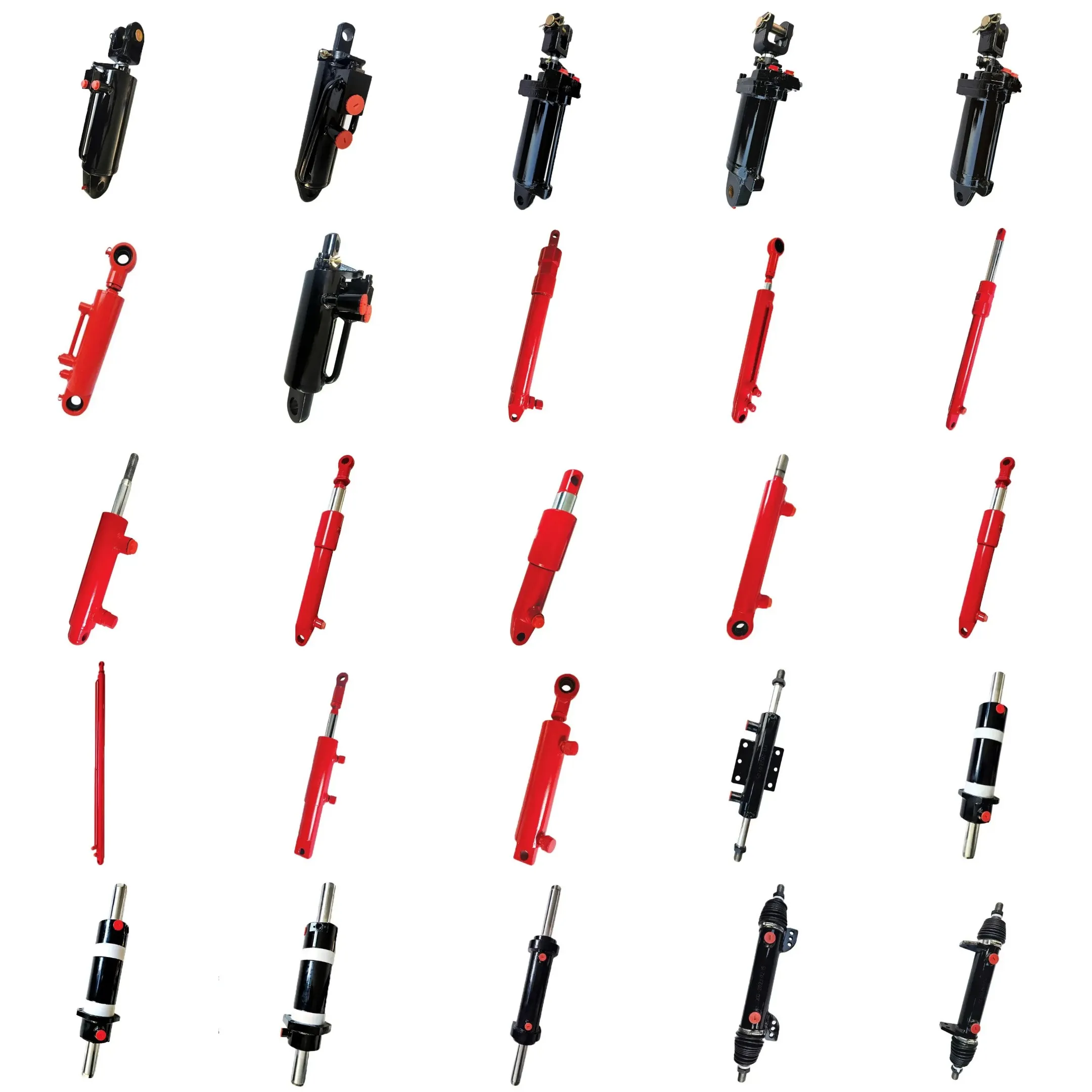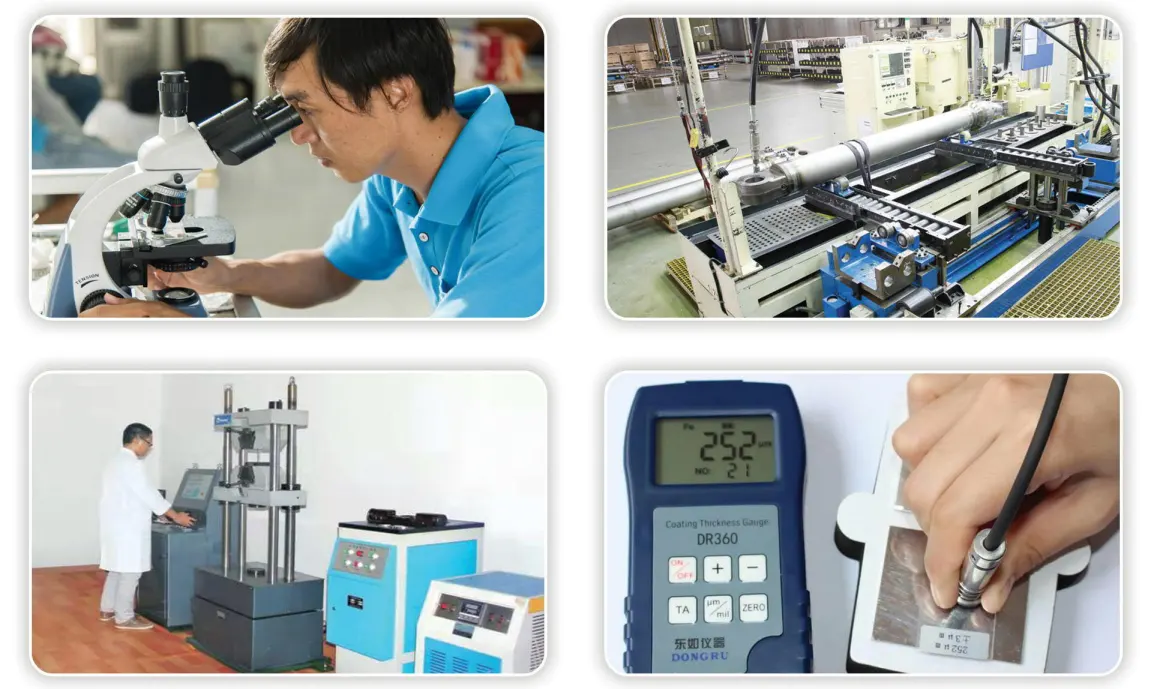Crawler Transport Vehicle Dump Hydraulic Cylinder
Sebagai salah satu produsen, pemasok, dan eksportir silinder hidrolik, Kami menawarkan silinder hidrolik dan banyak produk lainnya.
Silakan hubungi kami untuk informasi lebih lanjut.
Surat:sales@hydraulic-cylinders.net
Produsen pemasok eksportir silinder hidrolik.
Crawler Transport Vehicle Dump Hydraulic Cylinder
Product Introduction
The Crawler Transport Vehicle Dump Hydraulic Cylinder is a crucial component in the operation of crawler vehicles used for transporting and dumping materials. This hydraulic cylinder facilitates the lifting and lowering of dump beds, enabling the efficient unloading of materials such as gravel, soil, and other aggregates. Designed to handle substantial loads, this hydraulic cylinder ensures smooth and reliable operation, which is essential for construction, mining, and agricultural applications. Its robust design contributes to enhanced durability and performance, making it an indispensable part of various heavy machinery. The cylinder uses hydraulic pressure to create motion, translating energy into mechanical work, thereby optimizing the overall efficiency of the vehicle’s operations.
Product Specifications
- Cylinder Diameter: 40mm
- Rod Diameter: 20mm
- Travel: 340mm
- Installation Distance: 480mm
Understanding these specifications is essential as they determine the performance and compatibility of the hydraulic cylinder with various equipment. The cylinder diameter impacts the force the cylinder can exert, while the rod diameter influences its strength and stability. The travel distance defines how far the cylinder can extend and retract, crucial for adjusting the articulation of the dump mechanism. The installation distance affects how well the cylinder can fit into different machinery configurations, ensuring optimal functionality.
Features of the Hydraulic Cylinder
- High Load Capacity: Capable of handling heavy loads without compromising performance.
- Durable Construction: Made from high-strength materials to withstand harsh operating conditions.
- Efficient Sealing: Equipped with advanced sealing technologies to prevent hydraulic fluid leakage.
- Versatile Applications: Suitable for various industries including construction, mining, and agriculture.
- Custom Manufacturing: Our company can produce this hydraulic cylinder tailored to specific requirements.
Applications of the Hydraulic Cylinder
Construction Machinery
In construction, this hydraulic cylinder plays a vital role in dump trucks, excavators, and other heavy machinery. It allows for precise control over the dump beds, ensuring materials are unloaded exactly where needed. The ability to lift and lower heavy loads enhances productivity on construction sites, allowing for quicker project completion. With its robust design, the cylinder can withstand the rigors of construction environments, making it a reliable component that contributes to operational efficiency.
Agricultural Equipment
In agriculture, the hydraulic cylinder is essential for the operation of dump trailers and loaders. It facilitates the loading and unloading of bulk materials like fertilizers and grains, streamlining farming operations. The cylinder’s design ensures that it can handle the demands of agricultural work, providing farmers with a dependable solution for material transport. This functionality not only enhances productivity but also reduces labor costs, making farming operations more efficient.
Mining Operations
In the mining industry, hydraulic cylinders are utilized in dump trucks and other heavy equipment to manage large volumes of material. They help in the efficient transfer of ore and waste materials, which is critical for the overall mining process. The durability and reliability of the hydraulic cylinder ensure minimal downtime, which is essential in a high-stakes environment where time is money. Their robust construction allows them to operate under extreme conditions, ensuring longevity and dependable performance.
Design Considerations and Selection Criteria
Load Capacity
The load capacity of a hydraulic cylinder is one of the primary considerations during the design phase. It determines how much weight the cylinder can safely lift without risk of failure. Engineers must evaluate the maximum loads the cylinder will encounter during operation and ensure that the design meets or exceeds these requirements. This involves choosing robust materials and optimizing the geometry of the cylinder to enhance strength while keepingWeight limits in mind. Proper calculations and testing are crucial to ensure that the cylinder performs reliably under various load conditions.
Sealing Performance
Another key aspect is the sealing performance of the hydraulic cylinder. Seals are critical for preventing hydraulic fluid from leaking out, which can lead to decreased efficiency and potential damage. The design must incorporate high-quality seals that can withstand the pressures and temperatures experienced during operation. The choice of sealing materials, such as polyurethane or nitrile rubber, is vital, as these materials offer excellent wear resistance and longevity, ensuring effective sealing throughout the cylinder’s lifespan.
Durability and Longevity
Durability is paramount in the design of hydraulic cylinders, particularly in demanding applications such as construction and mining. The materials used in the cylinder’s construction must be resistant to wear, corrosion, and fatigue. Surface treatments may also be applied to enhance resistance to environmental factors, such as moisture and abrasive materials. A well-designed hydraulic cylinder can significantly reduce maintenance requirements and extend service life, providing a cost-effective solution for operators.
Safety Features
Safety is a critical consideration in hydraulic cylinder design. The cylinder must incorporate features that prevent failure during operation, such as burst protection mechanisms and pressure relief valves. These safety measures help protect both the machinery and the operator, reducing the risk of accidents. Moreover, regular safety inspections and maintenance are essential to ensure that these features function correctly, providing peace of mind to operators in high-risk environments.
Serviceability and Maintenance
Serviceability is an important factor in the design of hydraulic cylinders, as ease of maintenance can significantly affect operational efficiency. The design should allow for straightforward access to seals, fittings, and other components that may require inspection or replacement. Additionally, clear documentation and guidelines for maintenance procedures can help operators keep their equipment in optimal condition, minimizing downtime and enhancing productivity over time.
Sealing and Lubrication
Effective sealing and lubrication are crucial for the performance and longevity of hydraulic cylinders. Various sealing elements, including piston seals and rod seals, work together to prevent hydraulic fluid from leaking while maintaining pressure within the cylinder. The selection of sealing materials, such as polyurethane and nitrile rubber, is essential as these materials offer excellent resistance to wear and environmental factors. Furthermore, the cylinder body and threaded ends undergo meticulous surface finishing processes to improve wear resistance, ensuring optimal performance even in harsh conditions. Regular lubrication is necessary to maintain smooth operation and prevent wear on moving parts; operators should follow guidelines for replenishing hydraulic oil at appropriate intervals to ensure that the seals remain effective and the system operates seamlessly.
Preventive Maintenance Measures
- Regular Inspections: Conduct regular visual inspections to check for signs of wear or damage.
- Lubrication Checks: Ensure that the hydraulic oil levels are adequate and that the system is properly lubricated.
- Seal Replacement: Monitor seals for wear and replace them as necessary to maintain system integrity.
Implementing these preventive maintenance measures helps to identify potential issues early and prolong the operational life of the hydraulic cylinder. Regular inspections can catch minor problems before they escalate into major repairs, while proper lubrication keeps the system functioning smoothly. Additionally, proactively replacing seals can prevent costly leaks and downtime, ensuring the hydraulic system operates at peak efficiency.
Installation Guidelines
Proper installation of the hydraulic cylinder is critical for achieving optimal performance and longevity. Begin by ensuring that all mounting surfaces are clean and free of debris. Align the cylinder carefully with the mounting brackets, using appropriate tools to secure it in place without causing any misalignment. It is crucial to use suitable mounting brackets to provide adequate support and stability during operation. After securing the cylinder, connect the hydraulic lines, ensuring that all fittings are tight and leak-free. Once installed, test the system at low pressure to verify that the cylinder operates correctly before fully engaging it in operation. This careful approach to installation helps prevent future issues and ensures the hydraulic system functions as intended.
Common Maintenance Tasks
Regular Inspections
Conducting regular inspections is fundamental for maintaining the hydraulic cylinder’s performance. Operators should look for visible signs of wear, leakage, or damage during routine checks. Identifying potential issues early can prevent costly repairs and ensure smooth operation. Schedule inspections at regular intervals based on usage frequency and environmental conditions to keep the hydraulic system in optimal shape.
Appropriate Lubrication
Lubrication is essential for reducing friction and wear on moving parts within the hydraulic system. Ensure that hydraulic oil levels are sufficient and that the oil used is compatible with the cylinder’s materials. Regularly check the lubrication system for any leaks or blockages and replace oil according to the manufacturer’s recommendations to maintain efficiency and performance.
Seal Replacement and Calibration Checks
Seals are critical components that require regular monitoring and replacement as they wear out over time. Operators should establish a schedule for seal inspection and replacement to avoid leaks and maintain system pressure. Calibration checks ensure that the hydraulic cylinder operates within specified limits, enhancing safety and performance. Utilize proper tools and techniques for alignment and adjustment to achieve accurate calibration, ultimately improving the hydraulic system’s functionality.
Safety Considerations and Environmental Factors
When working with hydraulic cylinders, safety measures are paramount to prevent accidents and injuries. Operators should be trained in the safe use of hydraulic equipment, understanding the importance of personal protective equipment (PPE) and adhering to safety protocols during operation and maintenance. Moreover, consideration of environmental factors is essential. Proper disposal of hydraulic fluids and spent components is necessary to minimize environmental impact. Implementing a comprehensive safety and environmental management plan can help mitigate risks associated with hydraulic system operations.
Fault Diagnosis and Common Issues
- Leakage: This is one of the most frequent issues encountered. Leakage can occur due to worn seals or damaged fittings, leading to decreased performance and efficiency.
- Inconsistent Performance: Fluctuations in operation can indicate problems with the hydraulic fluid or air in the system, affecting the cylinder’s reliability.
- Overheating: This may result from excessive pressure or insufficient lubrication, leading to potential cylinder failure.
Diagnosing these issues requires careful observation and testing. Operators should regularly monitor the performance of the hydraulic system and use diagnostic tools to assess the condition of the cylinder. By identifying symptoms early, corrective actions can be taken before more significant problems arise, ensuring continuous and efficient operation of the hydraulic equipment.
Troubleshooting Tips and Solutions
To effectively troubleshoot hydraulic cylinder problems, start by systematically checking for leaks and ensuring all fittings are secure. Inspect seals regularly and replace them as needed to prevent loss of hydraulic fluid. For performance inconsistencies, examine the hydraulic fluid for cleanliness and adequacy. Air in the system should be purged to restore smooth operation. Overheating issues can be mitigated by ensuring proper lubrication and monitoring the pressure within the hydraulic system. These proactive measures not only enhance performance but also significantly reduce the likelihood of future failures.

About Our Company
As a leading manufacturer and wholesaler of hydraulic cylinders, our company boasts a comprehensive range of products designed to meet diverse industry needs. With our commitment to quality and innovation, we have established ourselves as a dominant force in both domestic and international markets. Our products hold international certifications, ensuring they meet strict safety and performance standards. We offer customized services to cater to specific requirements, utilizing advanced production equipment and technology to deliver superior products. Our dedicated after-sales service team is always ready to assist customers, ensuring satisfaction and support throughout the product lifecycle.


Author: lyl
Ikuti Tur Pabrik VR Kami:
Ikuti tur ke pabrik VR kami dengan yang berikut ini
Aplikasi Silinder Hidraulik:


